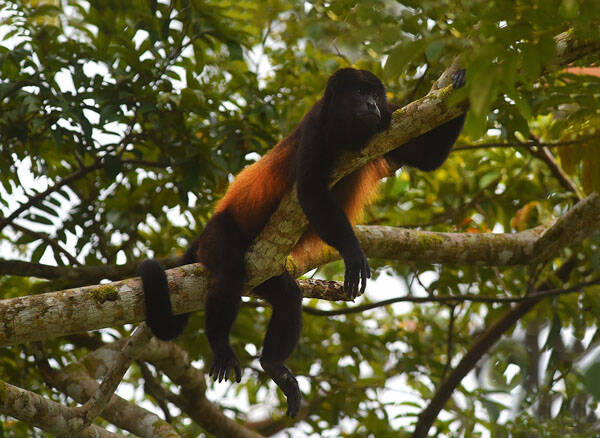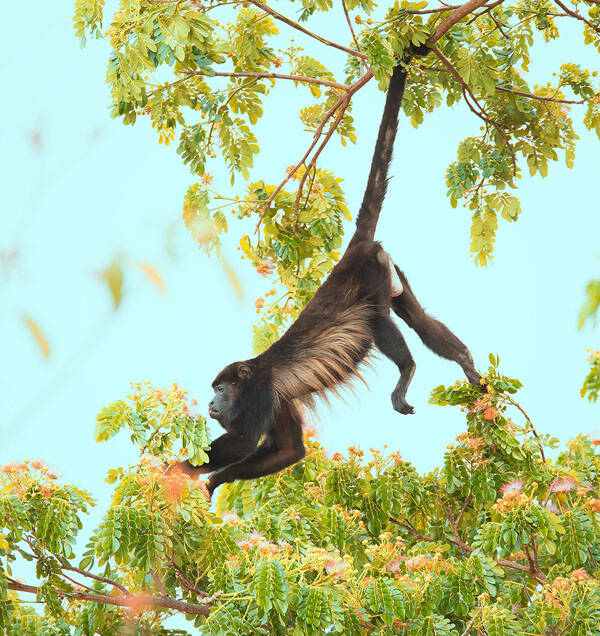Alouatta palliata
IUCN
LCBasic Information
Scientific classification
- name:Alouatta palliata
- Scientific Name:Alouatta palliata,Mantled Howler Monkey,Long-haired howler monkey
- Outline:Primates
- Family:H.monkeys
Vital signs
- length:46-63cm
- Weight:3.1-9.8kg
- lifetime:25+ years
Feature
It has long guard hairs on both sides, hence the name.
Distribution and Habitat
Distributed in Colombia, Costa Rica, Ecuador, Guatemala, Honduras, Mexico (Campeche, Chiapas, Oaxaca, Tabasco and Veracruz), Nicaragua, Panama, Peru.
The mantled howler monkey inhabits a variety of forest types, including secondary, semi-deciduous and riparian forests, but is restricted to areas with higher density and evergreen vegetation. The mantled howler monkey is commensal with the slow howler monkey in a narrow area of Guatemala and Mexico near the Yucatán Peninsula.
Appearance
The mantled howler monkey is one of the largest monkeys in Central America, about the size of a black-handed spider monkey. The head and body length of males is 47-63 cm, and that of females is 46-60 cm; the tail length of males is 60-70 cm, and that of females is 55-66 cm. The weight of males is 4.5-9.8 kg, and that of females is 3.1-7.6 kg. The brain of an adult howler monkey weighs about 55.1 grams. The average weight varies greatly, as there are five subspecies, depending on the population living in different places.
They are the most commonly seen and heard primates in many national parks in Central America, including Manuel Antonio National Park, Corcovado National Park, Monteverde Cloud Forest Reserve, and Soberania National Park.
Mantled howler monkeys are larger than females, and their faces are bare and hairless, but males have beards. They look like other howler monkeys, but their fur is black with golden to red hair on the sides. When males reach sexual maturity, thei
Details
Mantled Howler Monkey (scientific name: Alouatta palliata) is also known as Mantled Howler Monkey in foreign languages. There are 5 subspecies and it is one of the most common and heard monkeys in Central America.

Mantled Howler Monkeys live in groups. Their groups have about 10-20 members, usually 1-3 adult males and 5-10 adult females, and some groups can have more than 40 members. Males have higher status than females in the group, and younger ones have higher status than older ones. The more senior ones can choose food and resting places, and the dominant male can have the right to mate. Many members of the group have no relatives or blood relations, because most members will leave the group when they reach sexual maturity. Mantled howler monkeys rarely groom, and only the senior ones will groom the lower-ranking howler monkeys. There is rarely any aggressive behavior between members of the group, and even if there is, it will be quickly calmed down or carried out quietly. They rarely come into contact with other monkeys living together, but sometimes they will conflict with capuchins, and the conflicts are often caused by capuchins, which are smaller than mantled howler monkeys. In addition, the young monkeys of both groups will play together, or forage together in the same tree, and ignore each other. Mantled howler monkeys live in an area of 10-60 hectares. They rarely defend their territories, and often the territories of several groups overlap. However, when two groups meet, they will aggressively exclude each other from their territory. On average, a group moves about 750 meters per day.
Howler monkeys are arboreal. They are active during the day, walking on all fours, hanging and climbing trees. They sometimes jump from one tree to another. Howler monkeys are not very active animals. They sleep all night and three-quarters of the time, and their active time is foraging, and only 4% of the day is social. This lifestyle is adapted to their low-energy diet. They use their tails to hold branches when sleeping, resting or eating. The tail alone can support the entire body weight, but most of the time it is supported by the tail and feet. They remember their walking routes and use markings to return to their foraging and resting places. Howler monkeys have never been seen using tools. However, since red howlers were found to use sticks to attack two-toed sloths, it is believed that mantled howlers may also use tools, but have not been discovered.
Male mantled howlers will roar in the early morning and evening, or when they are disturbed. Their calls are loud and can be heard from several kilometers away. They include grunts and repeated roars, which last for 4-5 seconds. The sound is amplified by their hyoid bones. The male's hyoid bone is 25 times larger than that of spider monkeys of similar size, and is like a drum. The female's call is higher-pitched, but not as loud as that of males. Their calls can help them locate each other, so that they don't have to walk around and face unnecessary threats. They use clucking to maintain contact with members of the group. Mantled howlers also use non-verbal communication. When they are distressed, they will rub urine on their palms, feet, tails and chests. They also rub branches against their throats to leave body odor. Females use their lips and tongues to invite mating. Their emotional state can be seen from their reproductive performance, and group members swing branches, which seems to be an expression of play. Howler monkeys are not discriminating against humans, but when harassed, they will urinate or defecate on humans.

Howler monkeys mainly eat leaves, which account for 50-75% of their total diet. They choose trees for foraging, preferring young leaves. Since some leaves are poisonous, they choose to reduce the level of toxins they inhale. Young leaves generally contain less toxins and more nutrients, and are easier to digest. They prefer leaves from fig trees. Although leaves are abundant, they contain very little energy, so they only choose a low-energy lifestyle, such as calling their companions and resting most of the time. In addition to leaves, howler monkeys also eat fruits, which can account for 50% of their food, sometimes even more than leaves. Figs are their favorite fruit. Flowers are the second most popular, especially in the rare season. They absorb water from their food, but sometimes they drink water from tree holes. They drink more water from tree holes during the rainy season. They also drink water from pineapples. Almost all howler monkeys also have trichromatic vision, which is different from the New World monkeys that only have dichromatic vision. Their vision may be related to their eating habits, which helps them distinguish the redder young leaves.
Howler monkeys are polygamous, and a male can mate with multiple females. The dominant male gets the exclusive right to reproduce, but when he is distracted, lower-ranking males can also mate. In some groups, lower-ranking males sometimes get to mate and father offspring. Top males generally maintain their status for about 2.5-3 years, during which time they will produce about 18 babies. Adult howler monkeys wag their tongues to woo. Females appear to use chemical signals to woo, as males sniff the females' genitals and urine. Reproduction is possible year-round, with a gestation period of about 186 days. The fur of young monkeys is silver at birth, turning lighter or golden in the next few days. The fur will then begin to darken, and will be the same color as adults at about 3 months old.
The young monkeys are cared for by the mother monkey, and they will cling to the mother monkey's chest for the first 2-3 weeks. After that, they will move to the mother monkey's back. The mother monkey will push the young monkey away at about 3 months old, but will still take care of it until it is 4-5 months old. When the young monkeys can walk on their own, the mother monkey will carry them across the trees. The young monkeys often play on their own. They start to be weaned at six months old, which also means that the mother monkey's care ends here. Adult females generally give birth every 19-23 months, but they have to wait until the previous young monkeys are weaned. Females reach sexual maturity at the age of 3 years, and males at 3.5 years old. The male's testicles will not fall until they reach sexual maturity. When they reach sexual maturity, the young monkeys are generally expelled from the group unless they are born from a higher-ranking mother monkey. In fact, many young do not survive to reach sexual maturity, as some high-ranking howlers will harass or kill young of lower rank to avoid competition with their own young. When an outsider male becomes the dominant male, he will usually kill all the young to get the females to mate with him more quickly. Predators such as cats, weasels, snakes and eagles will kill young monkeys. It is estimated that only 30% of young monkeys survive more than a year. If they survive, the mantled howler monkey can live to at least 25 years old.
The IUCN considers the mantled howler monkey to be of least concern. However, their numbers have been severely affected by environmental fragmentation and deforestation, and some populations have had to migrate as a result. Fortunately, the mantled howler monkey's low-energy lifestyle, small territory and ability to find food make them highly resilient. The mantled howler monkey is important to the ecosystem, helping to disperse seeds, which, after passing through the digestive tract, help to germinate. Dung beetles, which can help spread seeds and nutrient cycles, also seem to rely on the howler monkey for survival. The howler monkey is protected by Appendix I of the Washington Convention.
Listed in the 2008 Red List of Endangered Species of the World Conservation Union (IUCN) ver 3.1 - Least Concern (LC).
Listed in Appendix I of CITES of the Washington Convention as a protected animal.
Protect wildlife and eliminate game.
Maintaining ecological balance is everyone's responsibility!








